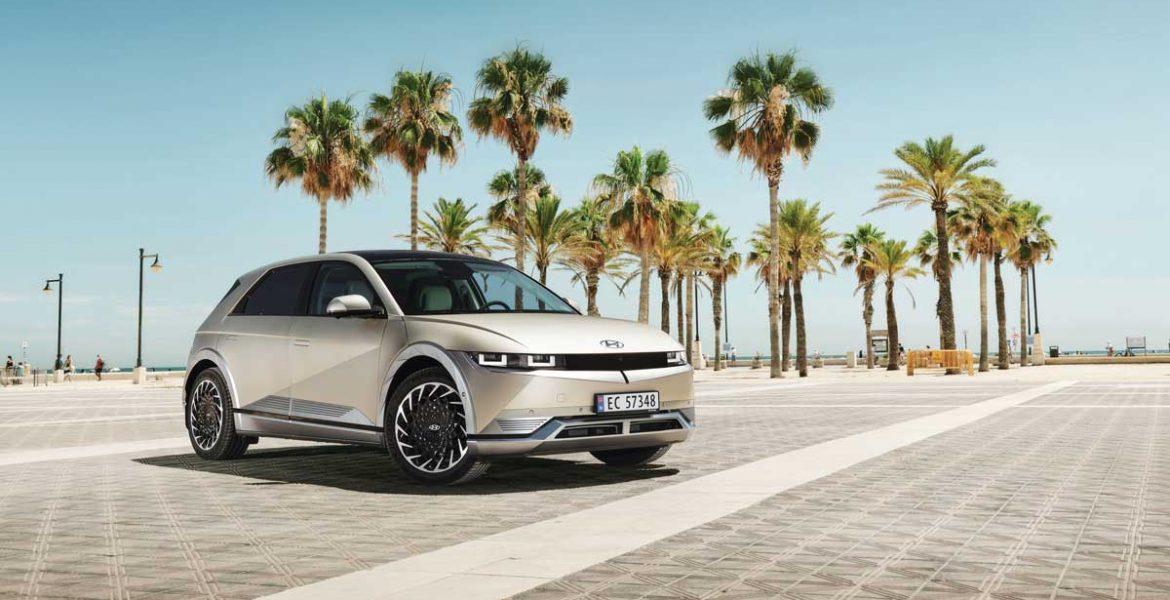HYUNDAI IONIQ 5
An Electric Revolution
Mat Ranasinghe explores Hyundai’s contribution towards an electric future

The Hyundai 45 EV concept was first introduced at the Frankfurt Motor Show 2019. And it took a couple of years more before the Ioniq 5 was available in the US. European and Asian countries such as Indonesia saw it in 2022, and it was for sale in Singapore and India this year.
This is the first model to use the Electric Global Modular Platform (E-GMP), which allows it to have a completely flat floor and a three metre wheelbase. A series of follow-on models, the second of which is the Kia EV6 and the recently released Hyundai Ioniq 6, are an indication of cross brand platform siblings.
A conceptual feature known as ‘e-Corner,’ which was displayed at the 2023 CES (Consumer Electronics Show), enabled the Ioniq 5 to move sideways (‘crab walking’) in a confined space. However, it is unlikely to make it into mainstream production. And even if it did, it’s likely that the local laws in many countries would prohibit its use due to safety concerns.
Ioniq 5 is manufactured in several countries including South Korea, Indonesia, Singapore and India. The Singaporean version will be the first locally produced automobile in almost 40 years. And the first hundred local cars will have special ‘First 100’ badging, embossed seats and commemorative registration plates.
Inspiration for the Ioniq 5 was drawn from the Hyundai Pony, which is a rear driven, midsized hatchback that was first released in the mid-1970s. Ioniq 5 does remind us of the original Pony, as well as the sci-fi movie Tron with its pixelated lamp design.
Although the Ioniq 5 is meant to be an SUV, its dimensions are more car-like. However, its sharp angles and creases may not be to everyone’s taste. It’ll be interesting to see how the design ages over the next decade.
For those who don’t like the overtly boxy styling, the Kia EV6 crossover with similar technical specs is an option worth considering.
And the benefit of that tall, boxy exterior becomes more apparent inside the light, airy, minimalistic cabin. There’s plenty of head and legroom for all the passengers, and that will be a strong selling point. The dashboard layout is simple and constructed using recycled materials. It has a long glass panel with two embedded 12 inch displays – one for the driver and the other for infotainment information.
It would have been better if the two screens had been seamlessly embedded behind the glass panel rather than displayed with two obvious frames. Options include digital side mirrors (DSM) with their own displays, a sliding (forward and backwards) centre console, the ability to power household electrical equipment off the car’s battery (‘vehicle-to-load’) and a panoramic fixed glass roof.
We wouldn’t recommend the last option in the tropics especially since we found the air conditioning a tad weak on hot and humid days.
Hyundai has resisted the temptation to embed the climate controls in the infotainment system. This feature is found in newer cars and many find it annoying. We found ourselves constantly pressing the wrong touch sensitive button as we tried to adjust the system while on the move.
The suspension of the Ioniq 5 is supple and compliant because it has been set up on the softer side of the spectrum unlike many rival electric vehicles (EVs). And there was an acceptable amount of body roll on cornering.
Is it a vehicle we would recommend? Definitely, along with a note of caution! Since it’s a first model, it is possible that the Ioniq 5 could experience a few teething problems. And if you search the internet, you’ll find that there have been some incidents where owners complained about rattles, uneven panel gaps and inadequate climate control systems.
Nevertheless, we didn’t find anything catastrophic such as battery issues or cars getting ‘bricked.’ There is an opportunity to import the Ioniq 5 (and/or EV6 and Ioniq 6) under the overseas remitter’s permit – so consider them also when making your shopping list!
HYUNDAI IONIQ 5
MODEL
A compact SUV designed specifically to cater to the growing demand for fully electric vehicles. The new model was seen in conceptual form a few years before Hyundai began officially releasing it from 2021 onwards. With stiff competition from rivals Tesla and BYD, Ioniq 5 has to prove its grit and secure itself in the EV ‘softroader’ niche.
ENGINES
Single motor rear-wheel drive or dual motor all-wheel drive. Available with standard (58 kWh), long range (72.6 kWh) and extra-long range (77.4 kWh) battery options.
FUEL
Range between 319 and 488 kilometres, depending on the model and battery choice.
OUTPUT
168 hp to 321 hp, depending on the variant; and 0-100 kmph dash in 5.1 seconds on the quickest model.
DRIVE
Many of today’s crossovers or softroaders are offered with front-wheel drive. The Ioniq’s argument as an SUV is further strengthened by the fact that it’s being offered with either rear-wheel or all-wheel drive.
VERDICT
It’s definitely a winner and the start of an electric revolution, of which the next chapter was the recently launched Ioniq 6. If these are the precursors to what lies ahead, the next 10 years will see the vehicular landscape change drastically!


